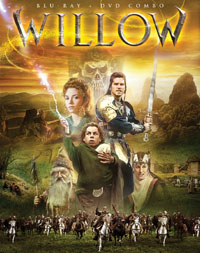 WILLOW
WILLOWBlu-ray Review
(PG)
MOVIE: ***1/2 (out of 5)
BLU-RAY EXPERIENCE: ** (out of 5)
STARRING
Warwick Davis as WILLOW UFGOOD
Val Kilmer as MADMARTIGAN
Joanne Whalley as SORSHA
Jean Marsh as QUEEN BAVMORDA
Patricia Hayes as FIN RAZIEL
Studio: 20th Century Fox
Directed by: Ron Howard
BY KEVIN CARR
I remember when “Willow” hit theaters in 1988. The studio was hoping it would be the next “Star Wars,” and there was a certain degree of reasoning behind it. The biggest reason is that it was backed by George Lucas, and it wasn’t illogical to think the man could do to the fledgling fantasy genre what he did to the science fiction genre a decade before.
Alas, “Willow” was not a hit. I remember seeing it in the theaters on its opening weekend, and I saw why it wasn’t a hit. While I enjoyed the film, it just didn’t have the spark that “Star Wars” had, even though it followed much of the same storyline with many similar characters.
So “Willow” ran its course back in the day, and eventually it settled onto home video. Over the years, it aged well and kept a lot of respect from fans. Now, it’s on Blu-ray, and it has become a forgotten classic that holds a lot of nostalgia.
The story follows Willow Ufgood (Warwick Davis), an average dwarf who stumbles into a prophecy. Willow must protect a baby who is to grow up to overthrow the evil Queen Bavmorda (Jean Marsh). On his quest to find safety, Willow joins with scoundrel and former knight Madmartigan (Val Kilmer) and various other rag tag characters along the way.
Watching “Willow” again, with a fresh Blu-ray transfer that Lucas himself oversaw, it now appears ahead of its time. In the 80s, fantasy films weren’t unheard of, but they tended to be dirtier, grimier and more adult. Films like “Dragonslayer” had brilliant effects but a soft delivery. Other movies like “Excaliber” just had a grungy feel that seemed plucked from the filthiest scenes of “Monty Python and the Holy Grail.”
It wasn’t until Hollywood threw some money and modern technology behind “The Lord of the Rings” and “Harry Potter” more than ten years later that fantasy got its due respect. But even more than the “Harry Potter” series, the “Lord of the Rings” films feel like an offshoot from “Willow,” considering their scope and location (shot in New Zealand, almost to the point of using the same vistas and rolling hills as backdrop).
There are still elements of “Willow” that reek of family films of the 80s. Forcibly cute moments are wedged into the movie, including several meant-to-be heartwarming bits back at Willow’s village. Also, unlike “The Lord of the Rings” and “Harry Potter,” “Willow” was clearly made as a family film. It has a definite message and employs a lot of storytelling that you’d see in children’s programming. This was how the film had to be framed in the late 1980s when the line had not yet blurred between kids movies and grown-up fare.
There are still moments in the movie that drag, but not too much. And for the most part, the effects don’t look too antiquated (and that groundbreaking morphing effect that really made people take notice in 1988 still looks pretty slick). This was a time when stop-motion was used, and that stuff still looks neat.
I showed “Willow” to my kids, and they loved it. It may never replace “Star Wars” in anyone’s heart, but it’s still a charming film that is fun to watch with the family.
The Blu-ray looks fantastic with vibrant colors and an image that takes full advantage of the beautiful scenery. The two-disc set includes a DVD of the film, with the special features found on the hi-def disc.
Special features include a couple deleted scenes with an introduction by director Ron Howard. There’s also featurettes that include “The Making of an Adventure” with Howard and “From Morf to Morphing” with digital artist Dennis Murin. Warwick Davis also has excerpts from his video diary he made during production, which is more interesting than a standard video diary because Davis was still a teenager and had the child-like fascination with the filmmaking process. The special features are rounded out with a spotlight on the striking matte paintings used in the film.
